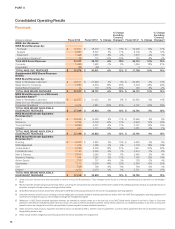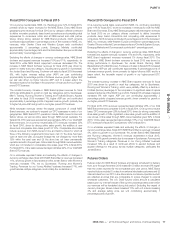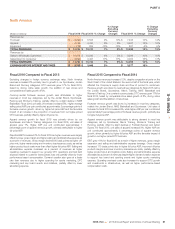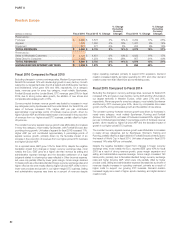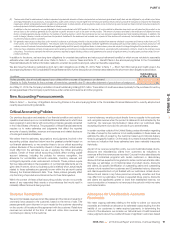Nike 2016 Annual Report Download - page 28
Download and view the complete annual report
Please find page 28 of the 2016 Nike annual report below. You can navigate through the pages in the report by either clicking on the pages listed below, or by using the keyword search tool below to find specific information within the annual report.
PART II
North America
(Dollars in millions) Fiscal 2016 Fiscal 2015 % Change
% Change
Excluding
Currency
Changes Fiscal 2014 % Change
% Change
Excluding
Currency
Changes
Revenues by:
Footwear $ 9,299 $ 8,506 9% 10% $ 7,495 13% 14%
Apparel 4,746 4,410 8% 8% 3,937 12% 12%
Equipment 719 824 -13% -13% 867 -5% -5%
TOTAL REVENUES $ 14,764 $ 13,740 7% 8% $ 12,299 12% 12%
Revenues by:
Sales to Wholesale Customers $ 10,674 $ 10,243 4% 5% $ 9,296 10% 10%
Sales Direct to Consumer 4,090 3,497 17% 17% 3,003 16% 17%
TOTAL REVENUES $ 14,764 $ 13,740 7% 8% $ 12,299 12% 12%
EARNINGS BEFORE INTEREST AND TAXES $ 3,763 $ 3,645 3% $ 3,077 18%
Fiscal 2016 Compared to Fiscal 2015
Excluding changes in foreign currency exchange rates, North America
revenues increased 8% primarily due to growth in our Sportswear, Jordan
Brand and Running categories. DTC revenues grew 17% for fiscal 2016,
fueled by strong online sales growth, the addition of new stores and
comparable store sales growth of 6%.
Currency-neutral footwear revenue growth was attributable to higher
revenues in most key categories, led by the Jordan Brand, Sportswear,
Running and Women’s Training, partially offset by a slight decline in NIKE
Basketball. Fiscal 2016 unit sales of footwear increased 8%. Higher average
selling price (ASP) per pair contributed approximately 2 percentage points of
footwear revenue growth, driven by higher full-price ASP and the favorable
impact of an increase in the proportion of revenues from our higher-priced
DTC business, partially offset by higher off-price mix.
Apparel revenue growth for fiscal 2016 was primarily driven by our
Sportswear and Men’s Training categories. For fiscal 2016, unit sales of
apparel grew 7%. Higher ASP per unit contributed approximately 1
percentage point of apparel revenue growth, primarily attributable to higher
full-price ASP.
Reported EBIT increased 3% for fiscal 2016 as higher revenues were largely
offset by lower gross margin and higher selling and administrative expense as
a percent of revenues. Gross margin declined 80 basis points as higher off-
price mix, higher warehousing and inventory obsolescence costs, as well as
higher product input costs more than offset higher full-price ASP. Selling and
administrative expense increased as a percent of revenues as higher
operating overhead to support our growing DTC operations and bad debt
expense related to customer bankruptcies was only partially offset by lower
performance-based compensation. Demand creation also grew at a faster
rate than revenues due to higher spending for sports marketing, DTC
marketing and key brand events and initiatives, partially offset by lower
advertising expense.
Fiscal 2015 Compared to Fiscal 2014
North America revenues increased 12%, despite congestion at ports on the
West Coast of the United States in the second half of the fiscal year, which
affected the Company’s supply chain and flow of product to customers.
Revenue growth was driven by nearly all key categories for fiscal 2015, led by
the Jordan Brand, Sportswear, Men’s Training, NIKE Basketball and
Women’s Training. On a constant currency basis, DTC revenue grew 17% for
fiscal 2015, fueled by comparable store sales growth of 8%, strong online
sales growth and the addition of new stores.
Footwear revenue growth was driven by increases in most key categories,
notably the Jordan Brand, NIKE Basketball and Sportswear. Unit sales of
footwear for fiscal 2015 increased 6%, while higher ASP per pair contributed
approximately 8 percentage points of footwear revenue growth, primarily due
to higher full-price ASP.
Apparel revenue growth was attributable to strong demand in most key
categories, led by Sportswear, Men’s Training, Women’s Training and
Running, partially offset by slight declines in Football (Soccer) and Action
Sports. For fiscal 2015, unit sales of apparel increased 9%. Higher ASP per
unit contributed approximately 3 percentage points of apparel revenue
growth, driven primarily by higher full-price ASP and the favorable impact of
growth in our higher-priced DTC business.
EBIT grew 18% for fiscal 2015 as a result of higher revenues, gross margin
expansion and selling and administrative expense leverage. Gross margin
increased 110 basis points due to higher full-price ASP, improved off-price
product margins and lower inventory obsolescence costs, partially offset by
higher product input and logistics costs. Selling and administrative expense
decreased as a percent of revenues despite higher demand creation expense
to support key brand and sporting events and higher sports marketing
expense. Operating overhead costs also increased to support DTC growth
and investments in infrastructure, as well as higher performance-based
compensation costs.
NIKE, INC. 2016 Annual Report and Notice of Annual Meeting 81
FORM 10-K







